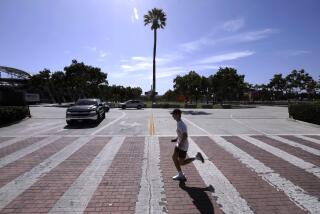Vines spreading at trees’ expense in tropical forests, scientists say
Vines may be proliferating at the expense of trees in tropical forests across the Americas, scientists have found. This shift in abundance could affect the water in the ecosystem and how carbon is stored in the plants, potentially drying out forests and resulting in more carbon dioxide in the Earth’s atmosphere.
The report, published online last week in the journal Ecology Letters, surveyed eight studies on the state of woody vines in tropical forests from the Savannah River system and the Congaree National Park in South Carolina to an area in the central Amazon about 50 miles north of Manaus, Brazil. They found that in all forests, vines were increasing in abundance, biomass or both.
“Global change is happening everywhere — and this is one of the first signs for tropical forests,” said Stefan Schnitzer, an ecologist with the Smithsonian Tropical Research Institute in Panama, who conducted the review with Frans Bongers of Wageningen University in the Netherlands.
Woody vines evolved to escape the dimly lit confines under the trees in tropical forests by climbing up tree trunks and branches, then spreading their networks of leaves over the dense treetops that make up the forest canopy. They block sunlight from the tree leaves they cover, and compete with the trees for water and nutrients.
Generally, Schnitzer said, about a quarter of the plants in a tropical forest will be vines. However, several studies in the last decade suggested that vines were growing faster and becoming more abundant. Before this study, Schnitzer added, no one had compiled the data to carefully look at the issue.
The scientists noted, for example, that a 2010 study on Panama’s Barro Colorado Island found that vines infested 75% of the crowns of trees in 2007, more than double the 32% rate in the late 1960s. A 2008 study of a forest in French Guiana found that from 1992 to 2002 vine abundance rose 1.8% while tree abundance dropped by 4.6%.
Several factors may be working in the vines’ favor, Schnitzer said. During the dry season, trees slow their rate of photosynthesis, in which they use sunlight to create energy out of water and carbon dioxide. Vines don’t slow their rate, and can therefore keep growing. If a tree falls or if loggers chop some trees down, vines can move into the empty space more quickly.
Vines also send their roots down in search of water and nutrients deeper than trees do and thrive more easily in the rising levels of carbon dioxide in the atmosphere, Schnitzer said.
The success of vines may mean failure for some trees. “Trees don’t grow as much when there’s a lot of vines,” Schnitzer said.
Fewer trees will reduce the amount of carbon stored in a forest, because they use a lot more carbon to make up their thick trunks than vines do. If there aren’t enough trees using up carbon in their trunks, “all that carbon dioxide is going to go back into the atmosphere,” Schnitzer said. About a third of the Earth’s terrestrial carbon stocks are in tropical forests.
In addition, forests will get dryer because vines can keep sucking water from the soil during dry seasons.
Robyn Burnham, an evolutionary biologist at the University of Michigan who was not involved in the study, said the next step would be to identify species of vines that pose the greatest threat. “Unless we understand those species, we might be doing what I think is racial profiling: We go out and arrest every vine out there, rather than figuring out if it’s done anything wrong yet.”





